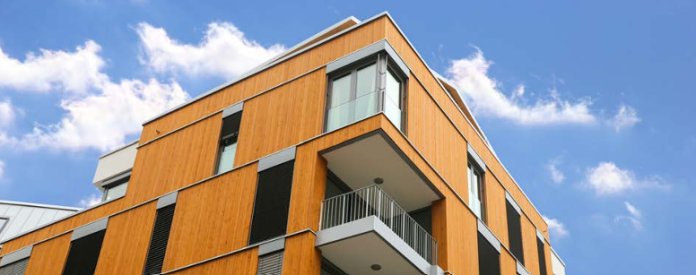Ontario Construction Report staff writer
Canada could become a world leader in sustainable construction if the country shifts to mass timber for buildings, a new RBC report concludes.
The report, Timber Rising: How Wood Can Spur Canada’s Green Building , found that steel and concrete in construction projects represent 92 megatons of carbon dioxide sent to the atmosphere in Canada – 13 per cent of all emissions in 2022. The building sector is the 3rd most carbon intensive industry in Canada.
Widespread adoption of wood, specifically mass timber, as a substitute or complement to concrete and steel could cut embodied emissions in buildings by as much as 25 per cent. Emissions could be cut by 5.5 megatons if one third of new large construction projects by 2030 were made with mass timber instead of steel and concrete.
“Now is the time for all players in the building sector to work together to act on these challenges and solutions and for Canada to showcase to the world that we are a nation of innovators in building construction and climate action,” Myha Truong-Regan, head of research at the RBC Climate Action Institute, wrote in the report.
Also, greater use of mass timber in building construction could conservatively grow the mass timber market by $1 billion by 2030. A share of this growth is anticipated to flow to Indigenous communities as they are in the employment catchment areas for logging sites, sawmills and mass timber manufacturing facilities.
“While towering steel-and-concrete structures once symbolized economic growth, they are now emblematic of the climate challenge that needs to be scaled,” Truong-Regan said. “The extensive use of carbon-intensive cement, steel and aluminum in buildings has made it the third most emissions-generating sector in Canada.”
Given Canada’s vast forest resources, the report made the case that the country could create a global marketplace for mass timber and become a world leader in the market when it comes to sustainable construction practices.
“We may be on the cusp of the next wave of sustainable buildings: made with low-carbon mass timber and assembled like an Ikea wardrobe to help bring down emissions,” Truong-Regan wrote.
A 25 per cent global market share would add $1.2 billion to the economy by 2030, the report said.
There are some hurdles to overcome with mass timber, however, as there are just 661 completed mass timber projects in Canada to date.
Notable mass timber projects include George Brown College’s Limberlost Place, the College of the Rockies Kootenay Centre South in Cranbrook, B.C. and the Winnipeg Humane Society.
Insurance premiums on mass timber projects can be 10 times higher than similar buildings made of steel and concrete, the report said, while the specialized tools needed for these projects are also much more expensive.
Standardizing insurance fire risks and government grants for mass timber projects could help reduce building costs, the report said.
“While towering steel-and-concrete structures once symbolized economic growth, they are now emblematic of the climate challenge that needs to be scaled. The extensive use of carbon-intensive cement, steel and aluminum in buildings has made it the third most emissions intensive sector in Canada.”

